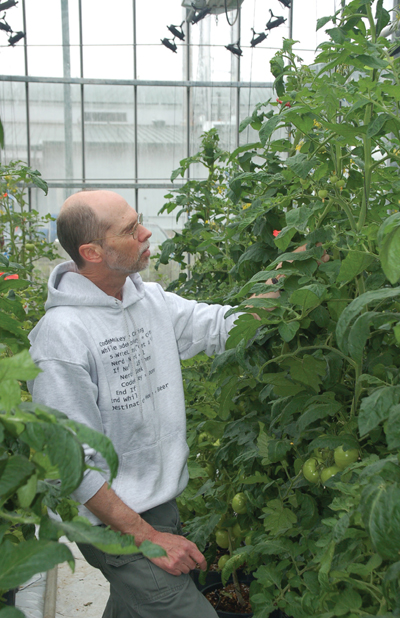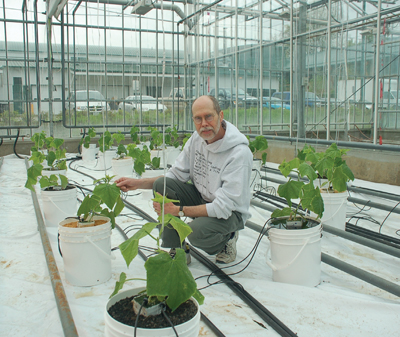
Greenhouse research scientist Dr. David Ehret of the Pacific Agriculture Research Centre in Agassiz, British Colombia, is part of two national studies also involving researchers at Harrow and other Agriculture and Agri-Food Canada research centres.
Greenhouse research scientist Dr. David Ehret of the Pacific Agriculture Research Centre in Agassiz, British Colombia, is part of two national studies also involving researchers at Harrow and other Agriculture and Agri-Food Canada research centres.
 |
|
| Dr. David Ehret Advertisement
|
|
 |
|
| looking over plants in this oxygenation project. | |

|
|
| Dr. David Ehret, with the start of new organic production trials
|
He detailed the two studies and results of his trials during the Grower Research Day at PARC.
The first project is a three-year study to develop fertilizer regimes for organic greenhouse vegetable production. While conventional growers have a variety of options to feed their crop, organic producers are limited to such non-synthetic production inputs as bone meal, composts, naturally mined salts, manure, non-GMO soybeans, liquid fish products, compost teas, blended liquids and seaweed extracts.
PRODUCT AVAILABILITY AMONG ORGANIC CHALLENGES
Dr. Ehret said the challenges include product availability, its effect on drippers and achieving the right nutrient balance.
Last year, he planted his spring tomato crop in 11-litre pots of yellow cedar sawdust. He then compared standard tomato feed with a combination of B.C.-sourced organic feeds (Fishplus, Pacific Natural, CalPril, DoloPril, citric acid and potassium sulphate), an American organic feed (MetaNaturals Grow and MetaNaturals Ca with potassium sulphate), and the American organic feed with added chlorine dioxide to keep the drippers clean.
The three organic feeds resulted in a 30 per cent drop in production compared to plants given a standard tomato feed. Irrigation lines also experienced increased accumulations of biofilm, the worst results coming from the American organic feed.
CAN ADDING COMPOST MAKE A DIFFERENCE?
In his second 2007 trial, Dr. Ehret used a feed composition similar to the B.C. formulation of the first trial but then tested the effect of adding 20 per cent compost to the yellow cedar substrate, as well as the effect of recirculation. While both recirculating systems showed production decreases compared to standard tomato feed, the non-recirculating system with compost added to the sawdust showed similar production to the standard feed. The compost-added substrate also showed a lower postharvest injury index.
“This is encouraging,” said Dr. Ehret, telling growers OMRI-approved made-in-B.C. liquid organic fertilizers “show promise.” Using them in combination with compost “may produce yields comparable to standard hydroponics.”
However, he is not sure growers will actually be able to use his findings, noting Canadian organic standards require greenhouses to use soil or a soil-based substrate and composted animal manure as the primary nutrient. “They don’t know what to do with greenhouse crops. I don’t think soilless production with only liquid feed will be allowed.”
As a result, additional trials will look at peat/perlite/compost substrates with and without clay and zeolite amendments, fed with a variety of locally sourced compost and a locally sourced supplemental liquid feed.
Although this is the final year of this three-year study, growers were told there will be at least another two years of “related research.”
ASSESSING THE EFFECTS OF OXYGEN ENRICHMENT
Dr. Ehret is also involved in a study to determine whether greenhouse crops can benefit from oxygen enrichment. In theory that should be the case, as roots need oxygen and water’s oxygen-holding capacity decreases as its temperature rises. In practice, however, that is not necessarily the case. Dr. Ehret noted previous studies on cucumbers, tomatoes, roses, peppers and watermelons have been inconsistent. Some show no effect, others show increased production or improved disease resistance in certain substrates.
Dr. Ehret has focused his research on cucumbers and peppers, using yellow cedar sawdust, new and old sawdust and/or perlite as substrate. The 2006 summer cucumber crop showed increases in number and weight of fruit with a high oxygen regimen but there were no significant improvements in any of his other 2006 or 2007 trials.
“There was never a negative effect but the results were very inconsistent,” he reported.
He suggested several reasons why the effects of oxygen enrichment have been inconsistent: oxygen is dissipating in the lines between irrigations; in porous substrates oxygen is mixing too rapidly with the ambient air; and/or micro-organisms in organic substrates are consuming the extra oxygen.
He is now trying an alternative irrigation strategy with an undrained substrate and experimenting with adding oxygen gas directly to the substrate. While initial results are “encouraging,” there is still not enough positive evidence to cause growers to reach for extra oxygen.
David Schmidt is a freelance writer and photographer in British Columbia.
Print this page